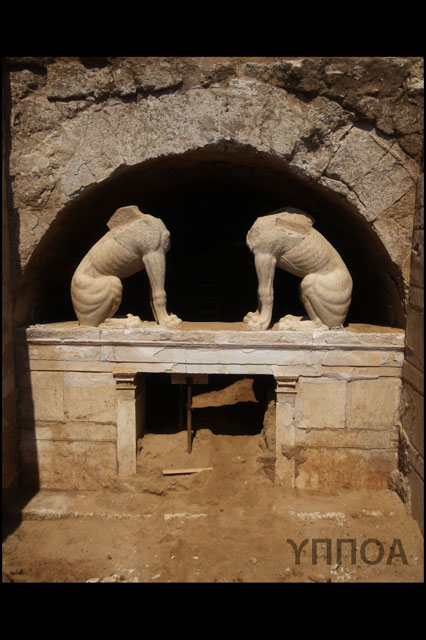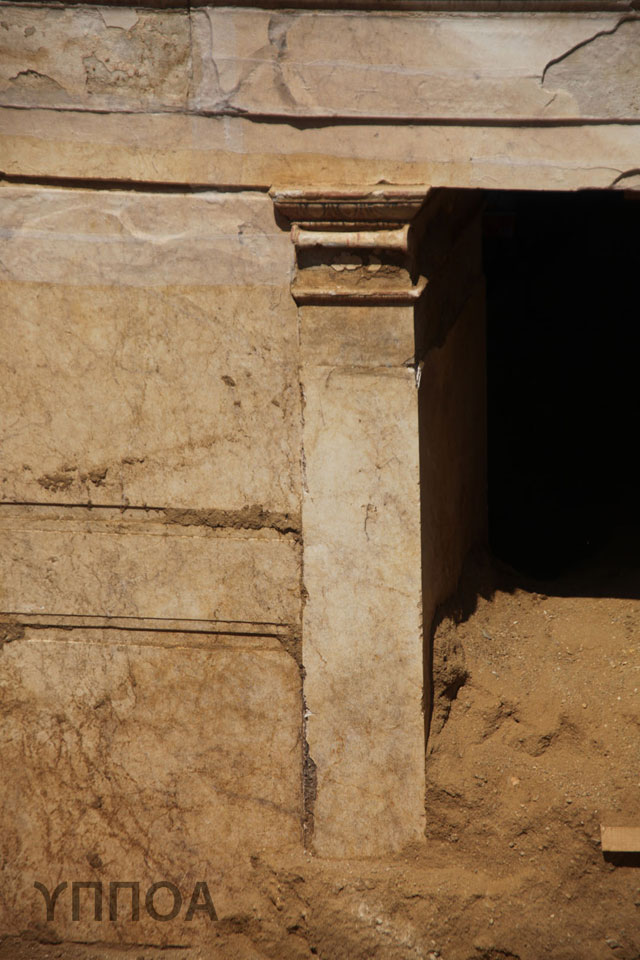Photos: Hellenic Ministry of Culture
The progress of the excavations of the tomb in Amphipolis has uncovered new findings. Archaeologists and members of the technical team have removed another 10 stone blocks forming the seventh and eighth lines of the wall that seals the tomb. According to the announcement of the Greek Ministry of Culture, three rows separate them from the removal of the 11-line structure.

Behind the blocks, archaeologists have discovered the continuation of the facade at the entrance of the tomb, the decoration of which is similar to that found on the side walls. It comprises of excellently made white frescoes that resemble the marble courtyard of the monument.

In parallel, the part of the marble pilasters that form the frame, which is under the capitals, is also covered with white frescos. The partial removal of the soil from behind the entrance has uncovered its rear part, which is also richly decorated like the front. There are traces of red and black paint on the frescos in the architraves. The side and rear parts of the Ionian capitals of the pilasters, which are covered with frescoes too, are also painted in the same colours.

The excavations are starting to uncover the side walls of the anteroom too. They are lined with Thassos marble and their upper part is decorated with Ionic architrave with traces of red and black paint on the edge.
In conclusion, the communication of the Ministry states that, along with the excavation works, expert restorers are carrying out activities related to the maintenance and assembly of the discovered decorations of the tomb.
While archaeologists are excavating the Kasta hill to find an unknown chapter from the history of ancient Amphipolis, on the opposite hill, where a modern village has been built over the old one, the local "archaeologists" are convinced that Alexander the Great himself was laid in the tomb.
Despite the fact that true archaeologists refute this possibility and expect to find in the tomb a noble general from the army of the great commander, the residents of the small village of Mesolakia, which is located at the foot of the hill, are already considering how to turn the findings to good advantage. "Upon entering the village we met a beekeeper. Even before asking him which way we must go to get to the tomb, he already showed a steep dirt road on which the Traffic Police have placed signs to orient visitors. "Over 2,000 people have passed by so far. This is mad, we have never seen so many people," says village mayor Stavros Zournatzis for "Kathimerini" newspaper. Some people are already considering opening shops for souvenirs and travel goods, others cafes, and a third group are simply calculating how much money they would make from the expropriation of their fields, which are located around the tomb. "It can be a great draw to us," the happy mayor tells correspondent for the newspaper Stavros Tzimas.
He continues, "Indicative is the conversation with four local "archaeologists" that took place in Nea Amphipolis under the shade of a huge acacia, right next to the local archaeological museum that is full of findings from legal and illegal excavations. "Here in Amphipolis, we are all "archaeologists" more or less. Well, some more than the others..." Those who know that Amphipolis is considered as El Dorado of smugglers of antiques is totally aware of what the interlocutor means. One of the group members had dug in Syria, Troy, FYROM, Bulgaria. There is even talk that he had spent several years in prison and, of course, that he knows the region as the palm of his hand. "This is no ordinary mound. Personally, I think that Alexander the Great was buried there. Late archaeologist Dimitris Lazaridis also believed that it was his grave but began digging at the wrong side. He used to say that what is buried here will change history," he says. And he is not the only one. "Digging" is a very old tradition in Amphipolis and some of its residents have provided themselves a significant income from it," says Tzimas.
According to the people, markets of antiques were often organized in the village in the 1950s and 1960s. Their customers, both Greeks and foreigners, provided a good income for the residents. They are so convinced that "they read the soil" and understand what lies beneath that their disappointment will be huge if the result of the excavations shatters their expectations for something "very big."
According to the report by Tzimas, the first commercial "site" in the region is already a fact - under the infuriated look of the Lion of Amphipolis Anestis Pavlidis from Strimoniko village is selling peanuts to visitors. "While the moment of truth is approaching and impatience growing, the majority of the experts are certain that the historical puzzle of ancient Macedonia will be filled to a large extent. However, one thing is certain, namely whether it was robbed or not, the tomb has yet to become a "martyr," concludes Tzimas.